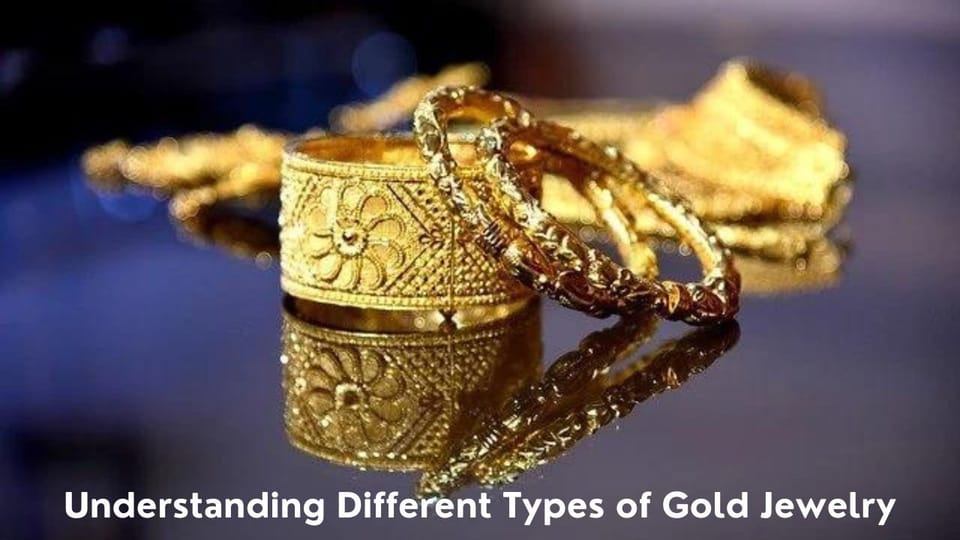Types of Gold Jewellery: Colors & Karats

Gold has captivated human beings for centuries with its timeless allure and value. While the phrase “All that glitters is not gold” suggests that not everything that shines is genuinely valuable, it also hints at the diverse nature of gold itself. The world of gold Jewellery is rich and varied, encompassing several types and styles, each with unique characteristics and value. In this comprehensive guide, we will explore the different types of gold jewelry, their distinct features, and key considerations to help you make informed decisions when purchasing gold Jewellery.
Types of Gold Jewelry:
- Gold Jewellery comes in several stunning colors, each achieved by alloying pure gold with different metals. Here’s a look at the most popular gold colors:
| Gold Color | Description | Common Alloys | Appearance | Durability |
|---|---|---|---|---|
| Yellow Gold | The classic gold color, naturally occurring and warm. | Silver, Copper, Zinc | Traditional and vibrant yellow. | Durable but softer compared to other types. |
| White Gold | A silvery-white metal created from yellow gold alloyed with nickel or palladium. | Nickel, Palladium, Zinc | Bright white finish, often Rhodium-plated. | Hard and resistant to tarnish; Rhodium plating may wear off over time. |
| Rose Gold | A pinkish hue achieved by adding copper to gold. | Copper | Soft pink or reddish color. | Strong and durable due to the copper content. |
Yellow Gold:
- Yellow gold remains a classic choice due to its rich, warm tone and timeless appeal. It is typically alloyed with silver, copper, and zinc to enhance its durability, as pure gold is too soft for everyday wear. Yellow gold is ideal for those who appreciate a traditional and elegant look.
White Gold:
- White gold is a popular alternative to platinum and silver. Created by alloying yellow gold with nickel or palladium and then plating it with Rhodium, white gold offers a sleek, modern appearance. The Rhodium plating provides a bright, shiny finish but may require periodic re-plating to maintain its luster.
Rose Gold:
- Rose gold, also known as pink gold, is distinguished by its distinctive pink hue from adding copper to the gold alloy. Due to the strength of copper, this type of gold is not only visually appealing but also quite durable. It’s an excellent choice for those who prefer a more romantic and vintage look.
Different Karats of Gold:
- Gold purity is measured in karats, with pure gold being 24 karats. Here’s a breakdown of the various karat levels:
| Karat | Gold Content | Description | Durability | Price |
|---|---|---|---|---|
| 24 Karat | 100% | Pure gold, very soft. | Least durable for daily wear. | Highest price due to purity. |
| 18 Karat | 75% | High purity, balanced with other metals for durability. | Durable and suitable for everyday use. | Higher price than lower karats but less than 24K. |
| 14 Karat | 58.3% | Popular choice, strong and durable. | Most durable and cost-effective for daily wear. | Lower price compared to 18K and 24K. |
24 Karat Gold:
- 24K gold is pure gold with no alloys mixed in. It is the most malleable and ductile form of gold, making it unsuitable for Jewellery that must withstand daily wear. Its high purity makes it more expensive but less practical for items subject to frequent use.
18 Karat Gold:
- 18K gold contains 75% gold and 25% other metals. This balance makes it both beautiful and durable. It is often chosen for high-end jewelry that needs to be both elegant and resilient.
14 Karat Gold:
- 14K gold is composed of 58.3% gold and 41.7% alloys. This type is highly durable and more affordable than higher karat options, making it a popular choice for everyday Jewellery.
Types of Gold Jewellery:
- Gold jewelry varies not just in color and karat, but also in the way it is constructed. Understanding these types can help you choose the right piece based on quality and longevity:
| Type of Gold Jewelry | Description | Gold Content | Durability | Cost |
|---|---|---|---|---|
| Gold Plated | Base metal with a thin layer of gold. | Less than 0.05% gold. | Can tarnish or wear off over time. | Least expensive. |
| Gold-Filled | Base metal with a thick layer of gold mechanically bonded. | Contains 100 times more gold than gold-plated. | Durable and long-lasting. | Mid-range price. |
| Gold Vermeil | Sterling silver base with thick gold plating. | At least 2.5 microns of gold. | More durable than gold-plated. | Mid to high-range price. |
| Solid Gold | Entirely made of gold with no base metals. | Varies by karat (14K, 18K, etc.). | Very durable based on karat. | Higher price due to purity. |
Gold Plated:
- Gold-plated jewelry is made from a base metal, such as brass or copper, with a thin layer of gold applied. This type is typically the most affordable but can lose its gold layer over time, especially with frequent wear.
Gold-Filled:
- Gold-filled Jewellery involves a base metal with a thick layer of gold bonded to it through heat and pressure. It contains significantly more gold than gold-plated jewelry, making it more durable and long-lasting, though still more affordable than solid gold.
Gold Vermeil:
- Gold vermeil is a type of jewelry that starts with a sterling silver base covered in a thick layer of gold through electroplating. It offers a balance between durability and affordability, with a more substantial gold layer than gold-plated items.
Solid Gold:
- Solid gold jewelry is made entirely from gold, with no additional base metals. The purity and durability of solid gold jewelry depend on its karat. It is the most expensive type due to its high gold content.
How many Types of Gold?
- 9K gold: 37.5% pure gold
- 10K gold: 41.7% pure gold
- 14K gold: 58.3% pure gold
- 18K gold: 75% pure gold
- 22K gold: 91.6% pure gold
- 24K gold: 100% pure gold
Conclusion:
- Choosing the right type of gold Jewellery involves understanding its color, karat, and construction. From the classic warmth of yellow gold to the modern shine of white gold, and the romantic tint of rose gold, each type offers unique benefits. Similarly, the construction methods—whether gold-plated, gold-filled, gold vermeil or solid gold—affect both the durability and cost of the jewelry. Armed with this knowledge, you can make an informed decision that suits your style, needs, and budget.
FAQs:
How can I tell if gold jewelry is genuine?
- Genuine gold jewelry often has a hallmark indicating its karat. You can also use a gold testing kit or consult a professional jeweler for verification.
How many types of gold are there?
What are the 5 types of gold?
- Gold jewelry primarily comes in three main colors: yellow gold, white gold, and rose gold. Additionally, gold quality varies, with common grades including 9K, 10K, 14K, 18K, and 22k, 24K gold.
Which type of gold is best?
which gold is best for jewellery?
- Pure gold is denoted as 24K, representing the highest karat level with 100% purity. 18K gold contains 75% gold, 14K gold is 58.3% gold, and 10K gold has 41.7% gold. Thus, as the karat number increases, the proportion of pure gold in the metal also increases.
What is the most expensive gold type?
- 24-karat gold consists entirely of pure gold, with no other metals mixed in. Due to its high purity, it is the most expensive type of gold. However, the high gold content makes 24-karat gold very soft, which means it can easily lose its shape with daily wear.
What color is the purest gold?
- Pure gold (24K or .999) is naturally yellow but is too soft for crafting delicate jewelry. To enhance durability and reduce cost, alloys are mixed with pure gold. The higher the gold purity, the more expensive the metal becomes. Adding alloys creates a more resilient metal suitable for a variety of jewelry pieces.
What is the difference between gold-plated and gold-filled jewelry?
- Gold-plated jewelry has a thin layer of gold applied to a base metal, while gold-filled jewelry has a thick layer of gold mechanically bonded to a base metal, making it more durable.
Is 24K gold suitable for daily wear?
- 24K gold is pure and very soft, making it less suitable for daily wear. It is often used in high-end jewelry and collectibles rather than everyday pieces.
What karat gold is best for engagement rings?
- 18K gold is a popular choice for engagement rings due to its balance of purity and durability. It provides a beautiful, high-quality look while being strong enough for daily wear.
How often should I clean gold jewelry?
- Gold jewelry should be cleaned regularly to maintain its luster. Use a mild soap solution and a soft brush, and avoid harsh chemicals. For intricate pieces, professional cleaning is recommended.
We hope that you like this content and for more such content Please follow us on our social site and YouTube and subscribe to our website.
Manage your business cash flows and payable/receivables using our Bahi Khata App




Comments ()